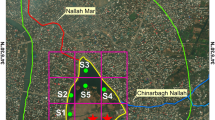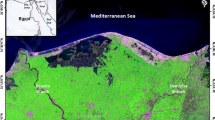Abstract
The growth of tourism often expedites the process of urbanization in terms of expanding built-up areas and other impervious surfaces at the cost of the original natural serenity. The coastal resort town of Digha, situated at the Medinipur coastal plain of West Bengal, India, had been developed after substantial land use conversions and loss of perennial interdunal wetlands. The effects of wetland transformations are more evident in terms of continuous ecosystem degeneration and reduction of subsistence-based livelihood provisions for the local populace. However, this trend of urban expansion was severely contested by the ‘smart city’ concept which the State Government had envisaged for the sustainable development of Digha Township in recent years. This new concept advocated for a balanced land use planning giving adequate attention to its green infrastructure and urban ecological standards towards develo** the cities of the new century. An appropriate assessment of the present patterns of urbanization and consequent environmental transformations thus becomes the prerequisite of any such development endeavour. In this context, the present study aimed to quantify the cumulative stress of expanding buildups on the interdunal wetland ecosystems around the renowned coastal resort town of Digha of this region through a coupling of geospatial technologies with statistical analyses. For this purpose, Normalized Difference Built-up Index and Soil Moisture Index were derived from the multispectral Landsat images of the year 2000 and 2018, respectively, as indicative physical and bio-physical parameters. The linear maximum likelihood regression model was then applied on these derivatives to infer the spatio-temporal relationships between the expansion of buildups and changes in wetland characteristics of this area. Results indicated that the magnitude of wetland encroachment was more severe within the newly developed high-density built-up areas. Moreover, the interdunal wetlands were found to be shrinking more rapidly in 2018 compared to that of the 2000 scenario in direct correspondence with the enhanced growth of built-up zones. Remarkably, a few sites in the rural fringes were also experiencing aggravated loss of soil moisture contents chiefly due to the establishment of isolated resort compounds and gated housing complexes in spite of being quite far from the core urban zones. Incessantly changing tourist preferences towards secluded lifestyles and demand for serene landscapes as well as lacklustre implementation status of land development regulations were primarily attributed to this sporadic nature of land use conversions in this region. Based on the findings, a few realistically attainable management guidelines have been recommended towards develo** a true ‘smart city’ in terms of both ecological composure and sustenance of tourism initiatives.
Access this chapter
Tax calculation will be finalised at checkout
Purchases are for personal use only
Similar content being viewed by others
Abbreviations
- DSDA:
-
Digha-Sankarpur Development Authority
- ETM :
-
Enhanced Thematic Mapper Plus (ETM+)
- GCPs :
-
ground control points (GCPs)
- ICT:
-
Information communication technology (ICT)
- LULC :
-
land use/land cover
- LST :
-
Land Surface Temperature
- LUDCP :
-
Land Use and Development Control Plan
- MPCS :
-
Multipurpose Cyclone Shelter
- NIR :
-
Near Infrared
- NDBI :
-
Normalize Difference Built-up Index
- NDVI :
-
Normalized Difference Vegetation Index
- OLI-TIRS :
-
Thermal Infrared Sensor
- RMSE :
-
root mean square error
- SMI :
-
Moisture Index
- SWIR :
-
shortwave infrared
- TIRS :
-
thermal infrared
- USGS :
-
United States Geological Services
References
Angel S, Blei AM, Civco DL, Parent J (2012) Atlas of urban expansion. Lincoln Institute of Land Policy, Massachusetts
Angiuli E, Trianni G (2014) Urban map** in Landsat images based on normalized difference spectral vector. IEEE Geosci Remote Sens Lett 11(3):661–665
Antrop M (2004) Landscape change and the urbanization process in Europe. Landsc Urban Plan 67(1–4):9–26
Boone CG, Fragkias M (2012) Urbanization and sustainability: linking urban ecology, environmental justice and global environmental change. Springer, Berlin
Bryant CR, Russwurm LJ, McLellan AG (1982) The city’s countryside: land and its management in the rural-urban fringe. Longman, UK
Candela G, Figini P (2012) The economics of tourism destinations. Springer, Berlin
Caragliu A, Del Bo C, Nijkamp P (2011) Smart cities in Europe. J Urban Technol 18(2):65–82
Chattopadhyay K (2000) Economic impact of tourism development: a linear programming approach. Ind Econ J 47(3):105–109
Dameri RP (2013) Searching for smart city definition: a comprehensive proposal. Int J Comput Technol 11(5):2544–2551
Dorigo WA, Wagner W, Hohensinn R, Hahn S, Paulik C, Xaver A, Gruber A, Drusch M, Mecklenburg S, van Oevelen P, Robock A, Jackson T (2011) The international soil moisture network: a data hosting facility for global in situ soil moisture measurements. Hydrol Earth Syst Sci 15(5):1675–1698
DSDA (2008) Statistics on DSDA. https://www.dsda.gov.in/index.php/home/dsda_statistics. Accessed 25 August 2018
DSDA (2013) Digha-Shankarpur integrated beachfront area development plan https://www.iczmpwb.org/main/pdf/pea/Digha%20Shankarpur%20Integrated%20Beachfront%20Area%20Development%20Plan.pdf. Accessed 25 August 2018
Gill SE, Handley JF, Ennos AR, Pauleit S (2007) Adapting cities for climate change: the role of the green infrastructure. Built Environ 33(1):115–133
Jackson TJ (1993) III. Measuring surface soil moisture using passive microwave remote sensing. Hydrol Process 7(2):139–152
Jim CY (1998) Urban soil characteristics and limitations for landscape planting in Hong Kong. Landsc Urban Plan 40(4):235–249
Julien Y, Sobrino JA (2009) The Yearly Land Cover Dynamics (YLCD) method: an analysis of global vegetation from NDVI and LST parameters. Remote Sens Environ 113(2):329–334
Khansari N, Mostashari A, Mansouri M (2014) Impacting sustainable behavior and planning in smart city. Int J Sustain Land Use Urban Plan 1(2):46–61
Li Y, Zhu X, Sun X, Wang F (2010) Landscape effects of environmental impact on bay-area wetlands under rapid urban expansion and development policy: a case study of Lianyungang. China. Landsc Urban Plan 94(3–4):218–227
Mascarenhas A (2004) Oceanographic validity of buffer zones for the east coast of India: a hydrometeorological perspective. Curr Sci 86(3):399–406
Mishra S (2004) Tourism management: the socio-economic and ecological perspective. Universities Press, Hyderabad
Mitsch WJ, Gosselink JG (2000) The value of wetlands: importance of scale and landscape setting. Ecol Econ 35(1):25–33
Mondal S, Sen J (2017) A framework of predictive analysis of tourist inflow in the beaches of West Bengal: a study of Digha-Mandarmoni beach. In: Mandal J, Dutta P, Mukhopadhyay S (eds) international conference on computational intelligence, communications and business analytics. Springer, Singapore, pp 161–176
Mukherjee S (2018) Journeys into the past historical and heritage tourism in Bengal. New Academic Publishers, New Delhi
Nam T, Pardo TA (2011) Conceptualizing smart city with dimensions of technology, people, and institutions. In: Proceedings of the 12th annual international digital government research conference: digital government innovation in challenging times, pp 282–291. ACM Publications, New York
Naphade M, Banavar G, Harrison C, Paraszczak J, Morris R (2011) Smarter cities and their innovation challenges. Computer 44(6):32–39
Pahari DP (2013) Coastal resorts of West Bengal: an environmental appraisal. PhD thesis, University of Burdwan, India
Parida BR, Collado WB, Borah R, Hazarika MK, Samarakoon L (2008) Detecting drought-prone areas of rice agriculture using a MODIS-derived soil moisture index. GISci Remote Sens 45(1):109–129
Potić I, Bugarski M, Matić-Varenica J (2017) Soil moisture determination using remote sensing data for the property protection and increase of agriculture production. In 2017 annual world bank conference on land and poverty. The World Bank, Washington DC
Prasad SN, Ramchandra TV, Ahalya N, Sengupta T, Kumar A, Tiwari AK, Vijayan VS, Vijayan L (2002) Conservation of wetlands of India-a review. Trop Ecol 43(1):173–186
Revi A, Singh AK (2007) Cyclone and storm surge, pedestrian evacuation and emergency response in India. In: Waldau-Drexler N, Gattermann P, Knoflacher H, Schreckenberg M (eds) Pedestrian and evacuation dynamics 2005. Springer, Berlin, pp 119–130
Roy AK, Datta D (2018) Analyzing the effects of afforestation on estuarine environment of river Subarnarekha, India using geospatial technologies and participatory appraisals. Environ Monit Assess 190(11):1–16
Ruddick S (2015) Situating the Anthropocene: planetary urbanization and the anthropological machine. Urban Geogr 36(8):1113–1130
Schroeder TA, Cohen WB, Song C, Canty MJ, Yang Z (2006) Radiometric correction of multi-temporal Landsat data for characterization of early successional forest patterns in western Oregon. Remote Sens Environ 103(1):16–26
Shapiro JM (2006) Smart cities: quality of life, productivity, and the growth effects of human capital. Rev Econ Stat 88(2):324–335
Staffans A, Horelli L (2014) Expanded urban planning as a vehicle for understanding and sha** smart, liveable cities. J Commun Inf 10(3):1–28
World Economic Forum (2016) Inspiring future cities & urban services sha** the future of urban development & services initiative. https://www3.weforum.org/docs/WEF_Urban-Services.pdf. Accessed 20 August 2018
Yang ZX, He XF (2010) Automatic extraction of urban land-use information from remote sensing images based on improved NDBI method. J Hohai Univ Nat Sci 38(2):181–184
Zha Y, Gao J, Ni S (2003) Use of normalized difference built-up index in automatically map** urban areas from TM imagery. Int J Remote Sens 24(3):583–594
Zhan Z, Qin Q, Wang X (2004) The application of LST/NDVI index for monitoring land surface moisture in semiarid area. Proceedings 2004 IEEE international geoscience and remote sensing symposium. IEEE, USA, pp 1551–1554
Zhang F, Zhang LW, **g-**g SHI, Huang JF (2014) Soil moisture monitoring based on land surface temperature-vegetation index space derived from MODIS data. Pedosphere 24(4):450–460
Zhang Y, Odeh IO, Han C (2009) Bi-temporal characterization of land surface temperature in relation to impervious surface area, NDVI and NDBI, using a sub-pixel image analysis. Int J Appl Earth Obs Geoinf 11(4):256–264
Acknowledgements
This study received financial supports extended by the University Grants Commission, India, to the first author (Fellowship Reference No. 3261/NET-JUNE 2015) and DST-SERB (File No. ECR/2017/003380) to the corresponding author.
Author information
Authors and Affiliations
Editor information
Editors and Affiliations
Rights and permissions
Copyright information
© 2021 Springer Nature Switzerland AG
About this chapter
Cite this chapter
Roy, A.K., Mitra, S., Datta, D. (2021). How Does Tourism Affect Urban Ecological Standards? A Geospatial Analysis of Wetland Transformations in the Coastal Resort Town of Digha, West Bengal, India. In: Sharma, P. (eds) Geospatial Technology and Smart Cities. The Urban Book Series. Springer, Cham. https://doi.org/10.1007/978-3-030-71945-6_20
Download citation
DOI: https://doi.org/10.1007/978-3-030-71945-6_20
Published:
Publisher Name: Springer, Cham
Print ISBN: 978-3-030-71944-9
Online ISBN: 978-3-030-71945-6
eBook Packages: HistoryHistory (R0)





